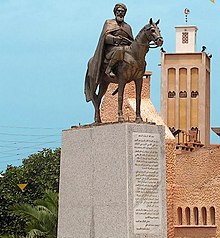
Back عبد المؤمن بن علي Arabic عبد المؤمن بن على ARZ عبدالمومن بن علی AZB আব্দুল মুমিন বিন আলী আল কৌমি Bengali/Bangla Abd-al-Mumin ibn Alí Catalan Abd al-Mu’min bin Alí Czech Abd al-Mu'min German Abd al-Mumin Spanish Abd al-Mumin Basque عبدالمؤمن بن علی Persian
| Abd al-Mu'min | |||||
|---|---|---|---|---|---|
| Caliph and Amir al-Mu'minin | |||||
 | |||||
| Ruler of the Almohad Caliphate | |||||
| Reign | 1133–1163 | ||||
| Successor | Abu Yaqub Yusuf | ||||
| Born | c. 1094 Tagra, Tlemcen, Hammadid kingdom[1][2][3] | ||||
| Died | 1163 (aged c. 69) Salé, Almohad Caliphate | ||||
| Spouse | Safiya bint Abi Imran | ||||
| Issue | Abu Yaqub Yusuf Aisha bint Abd al-Mu'min[4] | ||||
| |||||
| Dynasty | Almohad | ||||
| Father | Ali ibn Makhluf al-Kumi | ||||
| Mother | Ta'lu bint Atiyya ibn al-Khayr[5] | ||||
| Religion | Islam | ||||
Abd al Mu'min (c. 1094–1163) (Arabic: عبد المؤمن بن علي or عبد المومن الــكـومي; full name: ʿAbd al-Muʾmin ibn ʿAlī ibn ʿAlwī ibn Yaʿlā al-Kūmī Abū Muḥammad)[6] was a prominent member of the Almohad movement. Although the Almohad movement itself was founded by Ibn Tumart, Abd al-Mu’min was the founder of the ruling dynasty and creator of the Almohad empire.[7][8][9][10][11][12] As a leader of the Almohad movement he became the first Caliph of the Almohad Empire in 1133, after the death in 1130 of the movement's founder, Ibn Tumart, and ruled until his death in 1163. Abd al-Mu'min put his predecessor's doctrine of Almohadism into practice, defeated the Almoravids, and extended his rule across Al-Andalus (on the Iberian Peninsula) and as far as Tunis in Ifriqiya (present-day Tunisia), thus bringing the Maghreb in North Africa and Al-Andalus in Europe under one creed and one government.[13][14]
- ^ Magill, Frank Northen; Aves, Alison (1998). Dictionary of World Biography: The Middle Ages - Google Books. Routledg. ISBN 9781579580414.
'Abd al-Mu'min ibn 'Ali ibn Makhluf ibn Yu'la ibn Marwan, born in 1094 in Tagra (now in Algeria), was the son of Ali, a humble potter and member of the Koumiya, an Arabized section of the Berber Zanata tribe.
- ^ Cite error: The named reference
Encyclopedia Britannicawas invoked but never defined (see the help page). - ^ Fierro, Maribel. 2021. 'Abd al-Mu'min: Mahdism and Caliphate in the Islamic West. Simon & Schuster. "Having been born in Hammadid territory, 'Abd al-Mu'min must have been aware of this, and in his military expeditions the navy played an important role."
- ^ Fierro, Maribel (2021-11-04). 'Abd al-Mu'min: Mahdism and Caliphate in the Islamic West. Simon & Schuster. p. 73. ISBN 978-0-86154-192-8.
- ^ Fierro, Maribel (2021-11-04). 'Abd al-Mu'min: Mahdism and Caliphate in the Islamic West. Simon & Schuster. p. 69. ISBN 978-0-86154-192-8.
- ^ Cite error: The named reference
EI2was invoked but never defined (see the help page). - ^ The Cambridge Companion to Arabic Philosophy - Cambridge University PressBy Cambridge companion to philosophy
- ^ Oye, Ogun Journal of Arts, Volume 4 Faculty of Arts, Ogun State University
- ^ The Encyclopaedia of Islam: NED-SAMHamilton Alexander Rosskeen Gibb
- ^ The McGraw-Hill Encyclopedia of World Biography: An International Reference Work, Volume 1
- ^ The Religious Traditions of Africa: A History - Elizabeth Isichei
- ^ Encyclopaedia Britannica: Macropaedia: knowledge in depth. 19 vEncyclopaedia Britannica, Incorporated
- ^ Kojiro Nakamura, "Ibn Mada's Criticism of Arab Grammarians." Orient, v. 10, pgs. 89-113. 1974
- ^ Cite error: The named reference
:23was invoked but never defined (see the help page).